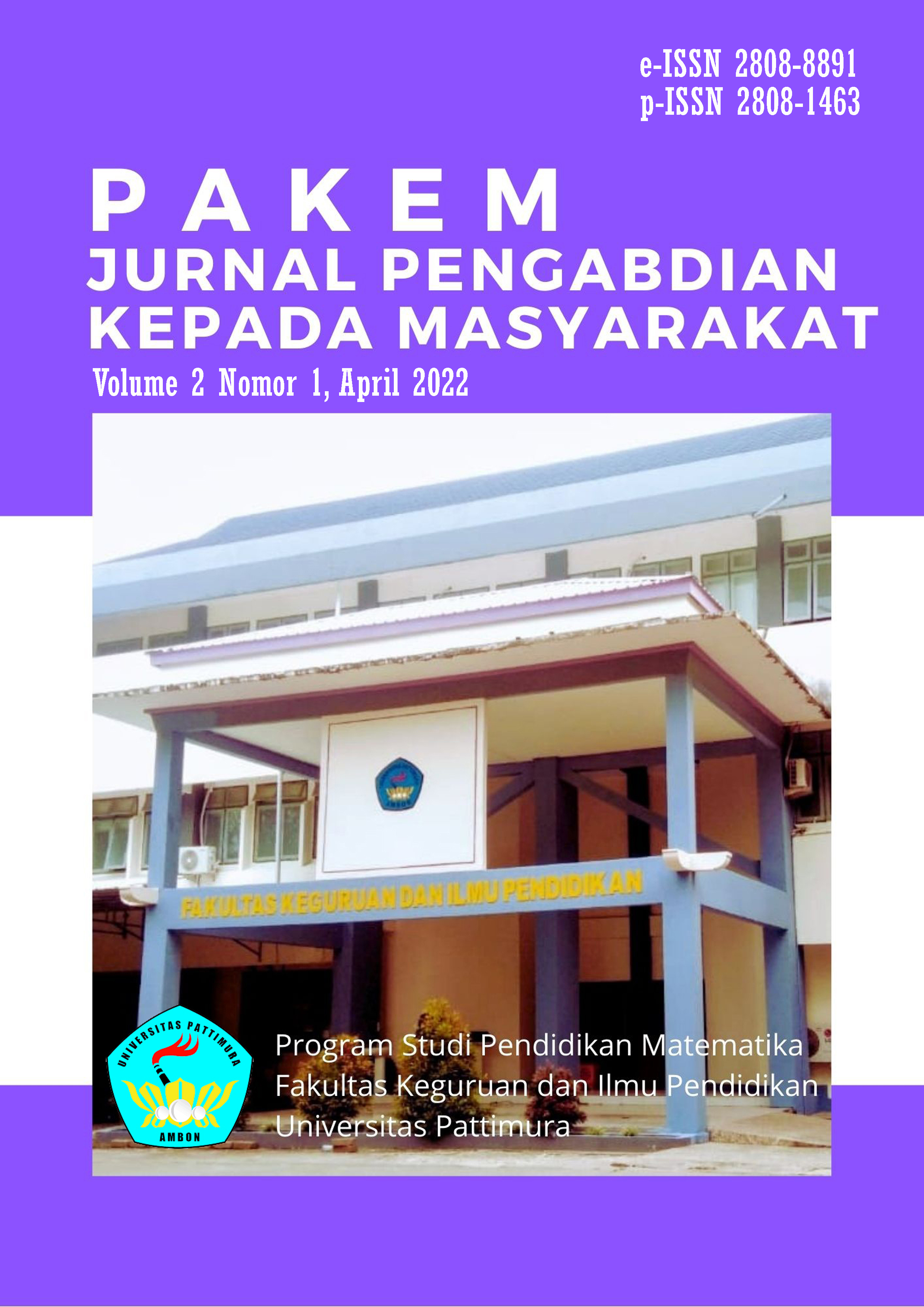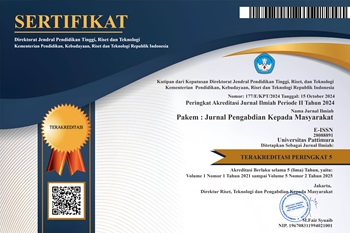PENERAPAN STS DI DESA DAYA TARIK MUSIK KOTA AMBON MEMBERDAYAKAN GANDARIA ENDEMIK MALUKU
Abstract
Application of science-technology-society (STS) in the village of Ambon City Music Attraction through empowerment of Gandaria (Bouea macrophylla) Maluku Endemic Plants. Community service is participatory in nature, namely the method of strengthening community capacity is not in the form of training but increases knowledge and skills that are normative. The service is carried out in Amahusu village as a tourist attraction village in Ambon city. The subjects in this service activity consisted of Mrs. PKK, and teenagers in Mahahusu village. The products produced include 6 snacks and beverages, namely: Yogurth, Nata, Wine, Dodol, Boble Tea, and Jelly drinks. Organoleptic test on color, aroma, texture, taste, and acceptability. This service program has changed the culture of the community into producing products. In addition to the ability of the program, it is hoped that the community will be more independent and just
Downloads
References
Agustin, F., & Putri, W. D. R. (2013). Making of Jelly Drink Averrhoa Blimbi L (Study About Belimbing Wuluh Proportion : The Water and Carrageenan Concentration). Jurnal Pangan Dan Agroindustri, 2(3), 1–9. https://jpa.ub.ac.id/index.php/jpa/article/view/46
Akcay, B., & Akcay, H. (2015). Effectiveness of Science-Technology-Society (STS) Instruction on Student Understanding of the Nature of Science and Attitudes toward Science. International Journal of Education in Mathematics, Science and Technology, 3(1), 37. https://doi.org/10.18404/ijemst.50889
AMO - Pemkot kembangkan daya tarik wisata musik di Ambon, tingkatkan kesejahtreraan warga - ANTARA News Ambon, Maluku. (n.d.). Retrieved April 19, 2022, from https://ambon.antaranews.com/berita/120361/amo-pemkot-kembangkan-daya-tarik-wisata-musik-di-ambon-tingkatkan-kesejahtreraan-warga
Anam, C. (2019). Mengungkap Senyawa pada Nata De Coco sebagai Pangan Fungsional. Jurnal Ilmu Pangan Dan Hasil Pertanian, 3(1), 42–53. https://doi.org/10.26877/jiphp.v3i1.3453
Andini, S., & Hobri., S. (2017). Students’ Activity in Problem-Based Learning (Pbl) Math Classroom Be Oriented Lesson Study for Learning Community (Lslc). International Journal of Advanced Research, 5(9), 1395–1400. https://doi.org/10.21474/ijar01/5458
Ashfarina, A. U., Harini, N., & Hendraningsih, L. (2020). Kajian Ekstraksi Karagenan Berdasarkan Variasi Rasio Rumput Laut (Eucheuma cottonii) dengan Nira Siwalan (Borrasus flaberina L.) dan Lama Perendaman serta Aplikasinya pada Bubuk Jelly Drink Nanas (Ananas comosus). Food Technology and Halal Science Journal, 3(2), 129. https://doi.org/10.22219/fths.v3i2.13214
Balvanera, P., Siddique, I., Dee, L., Paquette, A., Isbell, F., Gonzalez, A., Byrnes, J., O’Connor, M. I., Hungate, B. A., & Griffin, J. N. (2014). Linking biodiversity and ecosystem services: Current uncertainties and the necessary next steps. BioScience, 64(1), 49–57. https://doi.org/10.1093/biosci/bit003
Bishop, P., Pitts, E. R., Budner, D., & Thompson-Witrick, K. A. (2022). Kombucha: Biochemical and microbiological impacts on the chemical and flavor profile. Food Chemistry Advances, 1(October 2021), 100025. https://doi.org/10.1016/j.focha.2022.100025
Cano-La Madrid, M., Calin-Sanchez, Á., Clemente-Villalba, J., Hernandez, F., Carbonell-Barrachina, A. A., Esther, S., & Wojdyło, A. (2020). Quality Parameters and Consumer Acceptance. Foods, 9(516), 1–17. https://doi.org/10.3390/foods9040516
Carrageenans, G., & Hilliou, L. (2021). Structure – Elastic Properties Relationships in.
Chakona, G., & Shackleton, C. (2019). Food Taboos and Cultural Beliefs Influence Food Choice and Dietary Preferences among Pregnant. Nutrients, 11(2668), 1–18.
Cosman, F., de Beur, S. J., LeBoff, M. S., Lewiecki, E. M., Tanner, B., Randall, S., & Lindsay, R. (2014). Clinician’s Guide to Prevention and Treatment of Osteoporosis. Osteoporosis International, 25(10), 2359–2381. https://doi.org/10.1007/s00198-014-2794-2
Distefano, M., Mauro, R. P., Page, D., Giuffrida, F., Bertin, N., & Leonardi, C. (2022). Aroma Volatiles in Tomato Fruits: The Role of Genetic, Preharvest and Postharvest Factors. Agronomy, 12(2), 0–27. https://doi.org/10.3390/agronomy12020376
Domínguez, R., Pateiro, M., Gagaoua, M., Barba, F. J., Zhang, W., & Lorenzo, J. M. (2019). A comprehensive review on lipid oxidation in meat and meat products. Antioxidants, 8(10), 1–31. https://doi.org/10.3390/antiox8100429
Fahem, S. M., Hacieminoglu, E., & Yager, R. E. (2016). Features of Creativity that Improve Student Science Learning. 2(3), 73–81.
Forestell, C. A. (2017). Flavor Perception and Preference Development in Human Infants. Annals of Nutrition and Metabolism, 70(3), 17–25. https://doi.org/10.1159/000478759
Friesen, J. W. (2014). <i>Philosophical, Ideological, and Theoretical Perspectives on Education</i>, Gerald L.Gutek (2014). 2<sup>nd</sup> Ed. Boston, MA: Pearson. 452 p, including index. OALib, 01(01), 1–2. https://doi.org/10.4236/oalib.1100104
Gąsior, R., & Wojtycza, K. (2016). Sense of smell and volatile aroma compounds and their role in the evaluation of the quality of products of animal origin - A review. Annals of Animal Science, 16(1), 3–13. https://doi.org/10.1515/aoas-2015-0047
Ge, Y., Li, K., Xie, C., Xu, Y., Shi, C., Hang, F., & Doherty, W. O. S. (2021). Formation of volatile and aroma compounds during the dehydration of membrane-clarified sugarcane juice to non-centrifugal sugar. Foods, 10(7). https://doi.org/10.3390/foods10071561
Genva, M., Kemene, T. K., Deleu, M., Lins, L., & Fauconnier, M. L. (2019). Is it possible to predict the odor of a molecule on the basis of its structure? International Journal of Molecular Sciences, 20(12). https://doi.org/10.3390/ijms20123018
Hapanowicz, J. (2021). Two-phase liquid–liquid flow in the aspect of reduction of pumping power of hydrophobic substances with high viscosity. Energies, 14(9). https://doi.org/10.3390/en14092432
Holck, A., Axelsson, L., McLeod, A., Rode, T. M., & Heir, E. (2017). Health and safety considerations of fermented sausages. Journal of Food Quality, 2017. https://doi.org/10.1155/2017/9753894
Ikhsanudin, A., & Ningsih, L. (2017). Formulasi Krim Ekstrak Tomat (Solanumlycopersicum) dan Uji Aktivitas Antibakterinya terhadap Staphylococcus aureus ATCC 25923. Borneo Journal of Pharmascientech, 1(2), 1–7.
Inayah, S. N., Heremba, W. N. M. J., Samloy, Y., & Tuapattinaya, P. M. J. (2019). Uji Organoleptik Enhalus Tea Berdasarkan Cara Pengeringan Dan Tingkat Ketuaan Daun Secara Morfologi. Science Map Journal, 1(2), 65–72. https://doi.org/10.30598/jmsvol1issue2pp65-72
Ismail, N., Muhammad, M. S., Che Ishak, F. A., Arsyad, M. M., Karnjamapratum, S., & Sirison, J. (2021). The Malay’s traditional sweet, dodol: a review of the Malaysia’s heritage delicacy alongside with the rendition of neighbouring countries. Journal of Ethnic Foods, 8(1). https://doi.org/10.1186/s42779-021-00095-3
Karakaş, H. (2022). The Effect of Socioscientific Issues-Based Discussion Activities on the Attitudes of Primary School Teacher Candidates to the Life Science Teaching. 19(1), 17–36.
Karuni, E. R., Sari, A. M., Nursiwi, A., & Sanjaya, A. P. (2021). Isolation and Characterization of Wild Type Acetobacter xylinum from Nata de Coco Industry in Surakarta Residency . Proceedings of the 10th International Seminar and 12th Congress of Indonesian Society for Microbiology (ISISM 2019), 15(Isism 2019), 44–48. https://doi.org/10.2991/absr.k.210810.009
Lahiri, D., Nag, M., Dutta, B., Dey, A., Sarkar, T., Pati, S., Edinur, H. A., Kari, Z. A., Noor, N. H. M., & Ray, R. R. (2021). Bacterial cellulose: Production, characterization and application as antimicrobial agent. International Journal of Molecular Sciences, 22(23), 1–18. https://doi.org/10.3390/ijms222312984
Mardhiyyah, Y. S. (2019). the Study of Nutritional Value From Gresik Traditional Food Products. Agrointek, 13(1), 54. https://doi.org/10.21107/agrointek.v13i1.4863
Marques, C., Correia, E., Dinis, L.-T., & Vilela, A. (2022). An Overview of Sensory Characterization Techniques : Profiling Methods.
Mayasti, N. I. K., & Ari N, D. (2013). Pemanfaatan Ampas Basah Tapioka Sebagai Media Fermentasi dalam Pembuatan. Pangan, 22(4), 365–372.
McCain, H. R., Kaliappan, S., & Drake, M. A. (2018). Invited review: Sugar reduction in dairy products. Journal of Dairy Science, 101(10), 8619–8640. https://doi.org/10.3168/jds.2017-14347
Nainggolan, J. (2009). Kajian Pertumbuhan Bakteri A.xylinum dalam Kombucha-Rosela Merah pada Kadar Gula dan Lama Fermentasi yang Berbeda. Tesis, 1–103.
Novelina, Nazir, N., & Adrian, M. R. (2016). The Improvement Lycopene Availability and Antioxidant Activities of Tomato (Lycopersicum Esculentum, Mill) Jelly Drink. Agriculture and Agricultural Science Procedia, 9, 328–334. https://doi.org/10.1016/j.aaspro.2016.02.144
Nurwati, & Hasdar, M. (2021). Sifat organoleptik kue brownies dengan penambahan rumput laut (Eucheuma cottonii). Journal of Food Technology and Agroindustry, 3(2), 69–75.
Pereira, P. A. P., de Souza, V. R., Silva, A. A., Queiroz, F., Borges, S. V., Pinheiro, A. C. M., & Carneiro, J. de D. S. (2019). Influence of gelling agent concentration on the characteristics of functional sugar-free guava preserves. Emirates Journal of Food and Agriculture, 31(7), 501–510. https://doi.org/10.9755/ejfa.2019.v31.i7.1982
Pielak, M., Czarniecka-Skubina, E., & Głuchowski, A. (2020). Effect of sugar substitution with steviol glycosides on sensory quality and physicochemical composition of low-sugar apple preserves. Foods, 9(3). https://doi.org/10.3390/foods9030293
Rahardjo, M., Sihombing, M., & Anggraeni, M. K. (2020). Color development and antioxidant activity in honey caramel. IOP Conference Series: Earth and Environmental Science, 443(1). https://doi.org/10.1088/1755-1315/443/1/012041
Rizal, S., Nurainy, F., & Meiza, F. (2013). Pengaruh penambahan Sari Buah Jambu Biji Merah (Psidium guajava L.) dan Glukosa terhadap Total Bakteri Asam Laktat dan karakteristik Organoleptik Minuman Sinbiotik Cicau Hijau ( Premna oblongifolia Merr ). Jurnal Teknologi Industri Dan Hasil Pertanian, 18(2), 144–156. ttp://dx.doi.org/10.23960/jtihp.v18i2.144 – 156
Roopa, S., & Rani, M. (2012). Questionnaire Designing for a Survey. Journal of Indian Orthodontic Society, 46(4_suppl1), 273–277. https://doi.org/10.1177/0974909820120509s
Ross, P., Weinhouse, H., Aloni, Y., Michaeli, D., Weinberger-Ohana, P., Mayer, R., Braun, S., De Vroom, E., Van Der Marel, G. A., Van Boom, J. H., & Benziman, M. (1987). Regulation of cellulose synthesis in Acetobacter xylinum by cyclic diguanylic acid. Nature, 325(6101), 279–281. https://doi.org/10.1038/325279a0
Saha, D., & Bhattacharya, S. (2010). Hydrocolloids as thickening and gelling agents in food: A critical review. Journal of Food Science and Technology, 47(6), 587–597. https://doi.org/10.1007/s13197-010-0162-6
Sarifah Ainy, N., Lediawati, W., & Hadi, N. (2022). Uji Organoleptik Penambahan Jus Buah Jambu Biji Merah (Psidium guajava Linn) Terhadap Tingkat Kesukaan Responden Pada Yoghurt Susu Kambing Etawa. INSOLOGI: Jurnal Sains Dan Teknologi, 1(1), 18–27. https://doi.org/10.55123/insologi.v1i1.118
Seftiono, H., Panjaitan, G. Y., & Sumiasih, I. H. (2020). Study of The Effect of Sugar and Lime Juice Proportion on the Quality of Starf Ruit Sorbet. International Journal of Applied Biology, 4(1), 1–14. https://doi.org/10.20956/ijab.v4i1.9181
Shkembi, B., & Huppertz, T. (2022). Calcium absorption from food products: Food matrix effects. Nutrients, 14(1), 1–31. https://doi.org/10.3390/nu14010180
Spence, C. (2015). Just how much of what we taste derives from the sense of smell? Flavour, 4(1), 1–10. https://doi.org/10.1186/s13411-015-0040-2
Supavititpatana, P., Wirjantoro, T. I., & Raviyan, P. (2010). Characteristics and shelf-life of Corn Milk Yogurt. Chiang Mai University Journal of Natural Sciences, 9(1), 133–150.
Sutaryono, S., & Prasetyaningtyas, F. D. (2020). Penanaman Sikap Inspiratif Melalui Pendekatan Sains Teknologi Masyarakat. Scholaria: Jurnal Pendidikan Dan Kebudayaan, 10(2), 179–186. https://doi.org/10.24246/j.js.2020.v10.i2.p179-186
Szczesniak, A. S. (2002). Texture is a sensory property. Food Quality and Preference, 13(4), 215–225. https://doi.org/10.1016/S0950-3293(01)00039-8
Thalut, N., Fonchamnyo, D. C., & Sama, M. C. (2020). Financial Inclusion, Community Capacity Building and Pro-Wildlife Conservation Behavior around the Northern Periphery of Dja Biosphere Reserve, Cameroon. Journal of Socioeconomics and Development, 3(1), 47. https://doi.org/10.31328/jsed.v3i1.1323
Wang, Q. J., Mielby, L. A., Junge, J. Y., Bertelsen, A. S., Kidmose, U., Spence, C., & Byrne, D. V. (2019). The role of intrinsic and extrinsic sensory factors in sweetness perception of food and beverages: A review. Foods, 8(6), 1–27. https://doi.org/10.3390/foods8060211
Wardanu, A. P., & Uliyanti, U. (2015). Analisa Nilai Tambah Dan Kelayakan Agroindustri Nata De Coco Di Kabupaten Ketapang Kalimantan Barat. Jurnal Teknologi Dan Industri Pertanian Indonesia, 7(2). https://doi.org/10.17969/jtipi.v7i2.3276
Wati, I. K., Karyanto, P., & Santosa, S. (2014). Pengaruh Penerapan Model Pembelajaran Sains Teknologi Masyarakat ( STM ) Terhadap Hasil Belajar Biologi Siswa Kelas X SMA Negeri 3 Boyolali Tahun Pelajaran 2012 / 2013 The Influence of Science Technology Society ( STS ) Learning Model Toward Biology Learn. BIOEDUKASI. Issn: 1693-2654, 7, 21–25.
Yoruk, N., Morgil, I., & Secken, N. (2009). The Effects of Science, Technology, Society and Environment (STSE) Education on Students’ Career Planning. Online Submission.US-China Education Review v6 N8 P68-74 Aug 2009, 6(8), 7. http://131.211.208.19/login?auth=eng&url=http://ovidsp.ovid.com/ovidweb.cgi?T=JS&CSC=Y&NEWS=N&PAGE=fulltext&D=eric3&AN=ED506328
Copyright (c) 2022 PAKEM : Jurnal Pengabdian Kepada Masyarakat

This work is licensed under a Creative Commons Attribution-NonCommercial-ShareAlike 4.0 International License.
Authors who publish with PAKEM: Jurnal Pengabdian Kepada Masyarakat agree to the following terms:
- Authors grant copyright to the journal and right of first publication with the work simultaneously licensed under a Creative Commons Attribution License (CC BY-NC-SA 4.0)
- Authors are able to enter into separate, additional contractual arrangements for the non-exclusive distribution of the journal's published version of the work (e.g., post it to an institutional repository or publish it in a book), with an acknowledgment of its initial publication in this journal.
- Authors are permitted and encouraged to post their work online (e.g., in institutional repositories or on their website) prior to and during the submission process, as it can lead to productive exchanges, as well as earlier and greater citation of published work.


.jpg)













